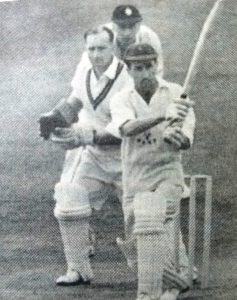Gilbert Parkhouse, the former Glamorgan and England batsman, died at a nursing home in West Wales on August 10, 2000, at the age of 74. Parkhouse appeared in 435 first-class matches for the Welsh county and won seven Test caps for England between 1950 and 1959.
He was considered by many to have been the most graceful of homered batsmen to play for Glamorgan. And season after season, he was one of the most consistent run-scorers in the first-class game. His record for the Glamorgan of centuries in the Country Championship against every other county side is still a unique one.
 Indeed, it was fitting that the Swansea-born batsman should achieve this feat in May 1960 with 121 against Leicestershire on St. Helen’s ground in Swansea. Where he had been coached hour after hour in the nets by the legendary Billy Bancroft, the former Glamorgan all-rounder and Welsh rugby international.
Indeed, it was fitting that the Swansea-born batsman should achieve this feat in May 1960 with 121 against Leicestershire on St. Helen’s ground in Swansea. Where he had been coached hour after hour in the nets by the legendary Billy Bancroft, the former Glamorgan all-rounder and Welsh rugby international.
Gilbert Parkhouse was educated at Wycliffe School in Gloucestershire. After some fine performances for the school cricket, he was even offered terms by the Gloucestershire club. However, Parkhouse had his roots firmly in South Wales, and it could not have been too difficult a decision for Gilbert Parkhouse to say no to the English county. He duly appeared for Glamorgan in their wartime friendlies in 1943 and, after completing his National Service, he made his first-class debut for Glamorgan in 1948.
Gilbert Parkhouse soon showed class as a middle-order batsman and scored over 1,200 runs in his debut season. Despite having a slight frame, he showed a wide range of forcing strokes. All made with immaculate timing, and following Glamorgan’s success in winning the County Championship. The English selectors took note of the talented young Welshman.
Gilbert Parkhouse also proved to be a fine fielder in the slips and close to the bat on the leg side, although it was no surprise that Parkhouse should have such a safe pair of hands as he had also played rugby for Swansea. In the 1950 season, Parkhouse moves up the batting order to partner opener Emrys Davies, the Stalwart left-handed opener. It immediately proved to be a most productive partnership, with a stand of 241 against Somerset and 233 against Surrey.
